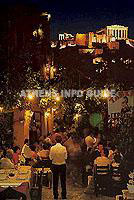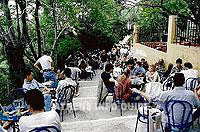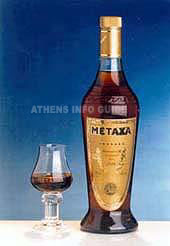 An
adventure... An
adventure...
Eating
out in Athens is an adventure. From street-eating, buying a Koulouri
(sesame seed bread ring) from a street vendor, or Galaktoboureko
(delectable custard-filled flaky pastry topped with a dusting
of icing sugar), to Tyropitta (cheese pies) or souvlaki (kebabs),
now known in most of Europe, one may eat a full meal just by traversing
the streets.
Fast
food restaurants are now added to the traditional tavern where
a cheap meal still usually can be had. Chinese, French, German,
Italian, Korean, Russian, you name it, Athens has a restaurant
serving their cuisine.
Greek
wines are measuring up to once producing only a lowly cousin to
retsina, the resinated wine, which is an acquired but good taste.
Nowadays Greek wines are becoming noticed internationally and
some are very good indeed.
Ouzo!
Ouzo??? No need to say anything about something as Greek as ouzo
is. You drink it and... start singing.
Eating out
 People
tend to love or hate Greek food. The spicing is unusual and lamb,
olive oil and fish are common ingredients. There's more to Greek
food however than gyros. If you've only experienced Greek cuisine
as a fast food in another country, you're in for a treat. Athens
has a wide variety of restaurants ranging from elegant to quaint.
Estiatorion are the more expensive conventional restaurants; taverna
are informal, family-run establishments; psistaria offer mostly
grilled meats and psarotaverna specialize in seafood dishes. Overall,
Greek food is healthy. Olive oil is good for you and will give
you some years more to enjoy the Greek cuisine. People
tend to love or hate Greek food. The spicing is unusual and lamb,
olive oil and fish are common ingredients. There's more to Greek
food however than gyros. If you've only experienced Greek cuisine
as a fast food in another country, you're in for a treat. Athens
has a wide variety of restaurants ranging from elegant to quaint.
Estiatorion are the more expensive conventional restaurants; taverna
are informal, family-run establishments; psistaria offer mostly
grilled meats and psarotaverna specialize in seafood dishes. Overall,
Greek food is healthy. Olive oil is good for you and will give
you some years more to enjoy the Greek cuisine.
The
"joie de vivre" of the Greeks is infectious. An evening
out, whether it be in metropolitan areas or in an island village,
will prove to be memorable and economical. Greeks in all walks
of life use evening dining as a principal source of entertainment.
They dine late and enjoy open-air places during the warm summer
months, even if air-conditioning is available. In most establishments
that cater to Greek clientele, service is likely to be friendly,
warm and informal. What usually happens when you walk into a restaurant
is, after finding a table, you will be permitted or encouraged
to go to the kitchen to see what they have to offer and make your
choice.
The
waiter will not be at your table every five minutes to ask you
if you need anything so you will have to attract his attention
when you do. It also is very normal that you keep ordering when
you see something you like being brought to another table after
having eaten what you ordered. A 15% service is included in the
food prices so you do not need to tip but you can always leave
something for the guy who clears the tables.
A
meal in Greece is highlighted with a selection of hors d' oeuvres,
hot and cold (referred to as mezedes), which are served in small
plates placed in the center of the table. Greeks are not connoisseurs
of soup but the few available are meals in themselves.
 Mezedes
are comprised of such items as melitzanosalata (mashed eggplant
with oil, lemon and garlic), taramosalata (Greek caviar spread),
dolmadakia (meat or rice rolled in grapevine leaves), kalamarakia
(deep fried squid), tyropitakia (cheese wrapped in strudel leaves),
kolokithakia (deep fried zucchini). They are usually served with
tzatziki, keftedes, octopus and more. Mezedes
are comprised of such items as melitzanosalata (mashed eggplant
with oil, lemon and garlic), taramosalata (Greek caviar spread),
dolmadakia (meat or rice rolled in grapevine leaves), kalamarakia
(deep fried squid), tyropitakia (cheese wrapped in strudel leaves),
kolokithakia (deep fried zucchini). They are usually served with
tzatziki, keftedes, octopus and more.
The
main course is a casserole or grilled fish. There are also many
meat stews to choose from as well as plain grilled cuts of meat
and of course the well-known souvlaki. Fish and shellfish are
excellent when caught, cooked and eaten the same day.
Salad
is usually ordered with the main course and can be prepared with
fresh vegetables or cooked dandelions (greens are boiled in water,
drained and served with oil and lemon). All seasonal vegetables,
such as artichokes, beans, peas, carrots, and zucchini are often
cooked and served together in the casserole dishes rather than
separately.
There
is a variety of cheeses produced in Greece. They include some
very interesting regional specialties. But the most commonly offered
in restaurants are feta (white semi-soft and salted), kasseri
(yellow semi-soft), graviera (hard) and manouri (unsalted creamy
and fattening). Cheese is usually consumed with bread which can
vary tremendously in flavor depending on the particular region.
Desserts
are a treat including baklava and kataifi. In the summer, however,
sweets give way to fresh fruits such as large peaches, melon,
watermelon, grapes and pears.
Greek
coffee is similar to Arabian coffee. The important thing to know
when ordering are the words pikro (bitter), metrio (semi-sweet)
and gliko (sweet). Coffee is usually served with a glass of water.

The Greek hamburger
One
of the most famous and most eaten Greek food is souvlaki. It is
usually beef, lamb or pork meat that is served on a round pita
bread with lettuce, tomato, onions, french fries and tzatziki.
That is if you eat it in a souvlaki shop. If you want take-out
the pita bread is rolled. You take it with you in packed in wax
paper which keeps it all together and eat it while walking. Souvlaki
is to Greece what the hamburger is to the US.
There
are a lot of good souvlaki shops in Athens especially on Mitropoleos
street, very close to Monastiraki square. One of the best in our
opinion is Bairaktaris on Monastiraki square on the corner with
Mitropoleos. The place always is very busy and waiters are shouting
orders but service is very friendly and you do not have to wait
long. They also serve the best Tzatziki you have ever tasted.
Tzatziki is a yogurt sauce with cucumber and a lot of garlic,
so much it will bite your tongue. You can enjoy your souvlaki
in the shop or take it with you. Souvlaki is cheap. When you are
looking for a quick meal, that is what you or your kids need.
See our restaurants
page. 
 Greek
wine Greek
wine
The
ancient Greeks revered wine and worshipped the wine-god Dionysus
for his precious gift. Wine was the inspiration for popular festivals
and sacred rites and ceremonies. Wine has been produced in Greece
for more than six thousand years. Its long history of wine
and wine-making have played an inseparable role in the country's
history affairs.
Greece's
6000 year old wine tradition has allowed the local wines to have
a distinct identity. During the last 20 years the wine producers
have been promoting wines of (AOC) Appellation d'Origine Controlee
quality.
Greek
wine is cultivated all over the mainland and the islands. Greek
vineyards are cultivated on mountain slopes of up to 800m above
the sea-level or at sea-level. The soil characteristics for the
majority of the vineyards is rocky limestone. There is also a
percentage that is cultivated on fertile plains. The vineyards
are spread over great areas of land but occupy small amounts of
it.
The
Greek landscape is ideal for unique microclimatic conditions favoring
the cultivation of local grape varieties. The combination of a
mild climate, a lot of sunshine and low rainfall make soils of
moderate fertility and small crops of excellent quality.
One
should not think too much about where, when, how or why when it
comes to Greek wines. One should just sit back and enjoy them.

Retsina
Retsina
has its origins in ancient Greece. Its history
goes back more than 3.000 years ago in Attica
region. It was born of the need to preserve and
ship wines in pine-pitch sealed vessels. Ancient
wines varied substantially in quality and tended
to spoil. In efforts to avoid this, wines were
often adulterated with exotic ingredients, from
herbs to seawater.
During
the archaic times Retsina took the final form we know today, that
of the use of resin in its preparation. From then, everything
remained the same and today, Retsina is one of the two national
drinks of Greece together with Ouzo.
Retsina
is a 100% Greek product. It is not produced in any other part
of the world except Greece. Made for more than 3,000 years, this
traditional Greek wine has been resinated (treated with pine-tree
resin). The resin gives the wine a distinctively sappy taste.
Today,
Retsina is produced in almost all parts of Greece but the best
is considered that of Attica.
Retsina's
are either white or rose and should be served cold. Retsina is
ideal as an accompaniment for all types of Greek cuisine. Like
most Greek beverages, it is undeniably at its best when combined
with Greek foods, especially the savoury mezedes served as appetizers.
Some
people, mostly non-Greeks, say that Retsina is an acquired taste.
Some other say that Retsina has a flavor as sappy and turpentine
like. We challenge you to try it out for yourself because if you
don't, you will never know what you are missing.The best is to
try it in its native environment. Maybe then you may well respond
to it like a true Greek! 
 Ouzo Ouzo
Ouzo
is a Greek anise-flavored liqueur that is widely consumed in Greece
and is considered to be the national Greek drink.
The history of ouzo is somewhat murky but some claim it may date
back in one form or another to ancient times. Its follower is
raki, a drink distilled throughout the Byzantine and later Ottoman
Empires, often in those days of quality approaching moonshine.
Similar liqueurs in Turkey and many Arab countries still go by
that name.
Modern ouzo distillation largely took off in the 19th century
following Greek independence, with much production concentrated
on the island of Lesvos, which claims to be the originator of
the drink and remains a major producer. In 1932, ouzo producers
developed a method of distillation in copper stills, which is
now considered the canonically proper method of production. However,
If you don't like liquorices you won't like Ouzo.
In modern Greece, ouzeri's can be found in nearly all cities,
towns, and villages. These cafe-like establishments serve ouzo
with mezedes, appetizers such as octopus, salad, sardines, calamari,
fried zucchini and clams, among others. It is traditionally slowly
sipped (usually mixed with water or ice) together with mezedes
shared with others over a period of several hours in the early
evening.
In many areas, individuals or small-time local producers make
tsipouro, which is essentially a home-made small-batch variant
of ouzo. The taste of tsipouro varies widely by producer, but
many Greeks prefer their favorite local tsipouro to the more commonly-available
brands of mass-produced ouzo. The traditional hospitality greeting
for travelers visiting the monasteries at Mount Athos is a small
glass of tsipouro and a loukoumi, a candy-like homemade treat.

Metaxa
Metaxa
is a special Greek spirit invented in 1888 in the Attica region,
the province of Athens by a silk trader named Spyros Metaxas.
Since then, the product has earned world recognition for its quality,
color and taste.
Metaxa
is distinguished as one of the most famous Greek spirit worldwide.
It is misled to be a brandy but actually it is something more.
Metaxa is produced from Savatiano, Sultanina and Black Corinth,
twice distilled, married with aged muscat wine from Samos and
Lemnos, blended with a secret botanical mix and then aged in hand-made
limousine oak casks.
In
the world market, Metaxa is generally available in three versions:
three, five and seven star. Each star represents a year that it's
been aged in oak barrels, thus the seven star is the most aged
and selected type. Generally speaking, it is relative easy to
find the three and the five star Metaxa in most liquor stores
but sometimes it is hard to find the seven star. Things are better
on the Greek market. The line of Metaxa available on the Greek
market is:
• Metaxa 3star (at least 3 years old).
• Metaxa 5star (at least 5 years old).
• Metaxa 7star Amphora (at least 7 years old).
• Metaxa Private Reserve (at least 20 years old).
There is no difference in terms of quality and production process
between the different Metaxa products. As in every family, age
is the only uncommon characteristic. In the Metaxa family, the
youngest is the 3* and the oldest vintage is the Private Reserve.
Some
types of Metaxa are very difficult to find or are found only at
selected shops around the world. A few of them are: Metaxa Centenary,
Metaxa Rhodes, Metaxa Golden Reserve, Metaxa Grand Olympian Reserve
and Metaxa Golden Age. All these types were bottled on special
occasions from selected old oak barrels that are kept in Metaxa
storage facilities.

 |

 An
adventure...
An
adventure... People
tend to love or hate Greek food. The spicing is unusual and lamb,
olive oil and fish are common ingredients. There's more to Greek
food however than gyros. If you've only experienced Greek cuisine
as a fast food in another country, you're in for a treat. Athens
has a wide variety of restaurants ranging from elegant to quaint.
Estiatorion are the more expensive conventional restaurants; taverna
are informal, family-run establishments; psistaria offer mostly
grilled meats and psarotaverna specialize in seafood dishes. Overall,
Greek food is healthy. Olive oil is good for you and will give
you some years more to enjoy the Greek cuisine.
People
tend to love or hate Greek food. The spicing is unusual and lamb,
olive oil and fish are common ingredients. There's more to Greek
food however than gyros. If you've only experienced Greek cuisine
as a fast food in another country, you're in for a treat. Athens
has a wide variety of restaurants ranging from elegant to quaint.
Estiatorion are the more expensive conventional restaurants; taverna
are informal, family-run establishments; psistaria offer mostly
grilled meats and psarotaverna specialize in seafood dishes. Overall,
Greek food is healthy. Olive oil is good for you and will give
you some years more to enjoy the Greek cuisine.  Mezedes
are comprised of such items as melitzanosalata (mashed eggplant
with oil, lemon and garlic), taramosalata (Greek caviar spread),
dolmadakia (meat or rice rolled in grapevine leaves), kalamarakia
(deep fried squid), tyropitakia (cheese wrapped in strudel leaves),
kolokithakia (deep fried zucchini). They are usually served with
tzatziki, keftedes, octopus and more.
Mezedes
are comprised of such items as melitzanosalata (mashed eggplant
with oil, lemon and garlic), taramosalata (Greek caviar spread),
dolmadakia (meat or rice rolled in grapevine leaves), kalamarakia
(deep fried squid), tyropitakia (cheese wrapped in strudel leaves),
kolokithakia (deep fried zucchini). They are usually served with
tzatziki, keftedes, octopus and more. 
 Greek
wine
Greek
wine
 Ouzo
Ouzo











